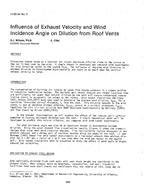Simultaneous experiments on the moisture behavior of six low-slope roof systems were performed in a climate simulator. The systems were composed of a self-drying design over a conventional metal deck, a self-drying design over a significantly more permeable slotted metal deck, and four other systems over conventional metal decks: a system typical of U.S. construction with a liquid water permeable vapor retarder, a system typical of European construction with a liquid water permeable vapor retarder, a top-ventilated system with a polyethylene vapor retarder, and an impermeable control system with a polyethylene vapor retarder. The total weight of each test panel was measured and recorded continuously, along with temperatures and heat fluxes, to compare the behavior of the various systems. We imposed steady-state temperatures from hot summer to cold winter conditions to obtain the R-values of the construction dry insulations in each panel. Temperature cycles typical of hot summer days and mild winter days were then imposed above the construction dry assemblies to obtain baseline diurnal performance. Enough water was added under the membrane of each system to saturate a layer of blotting paper. During the repeated diurnal cycles typical of hot summer days, the self-drying design over the slotted deck dried fastest, followed by the European construction with a liquid water permeable vapor retarder, then the self-drying design over the solid deck. When water was added to the systems, the lower membrane of the top-ventilated system had been slit in several places and this system dried at a slow rate. When the lower membrane was removed completely, the top-ventilated system dried as fast as the self-drying design over the solid deck. The control system and the U.S. construction with a liquid water permeable vapor retarder dried slowly at about the same rate. We applied a one-dimensional thermal and hygric model. The solid and slotted deck were assumed to differ only in water vapor permeance. A model was not attempted for the top-ventilated system. The 1-D model predicted very well the slow rates of wetting in the winter cycles and both the slow then fast rates of drying in the summer cycles before and after water addition; however, it overpredicted the drying rate for the U.S. construction with a liquid water permeable vapor retarder.
AUTHOR: Andre O. Desjarlais, Thomas W. Petrie, Ph.D., Phillip W. Childs, Jerald A. Atchley
CITATION: Thermal Performance of the Exterior Envelopes of Buildings VII
KEYWORDS: December, Florida, 1998
YEAR: 1998
Citation: Thermal Performance of the Exterior Envelopes of Buildings VII
Product Details
- Published:
- 1998
- File Size:
- 1 file , 670 KB
- Product Code(s):
- D-8116


